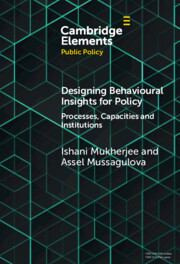Element contents
Designing Behavioural Insights for Policy
Published online by Cambridge University Press: 24 April 2024
Summary
- Type
- Element
- Information
- Series: Elements in Public PolicyOnline ISBN: 9781009264464Publisher: Cambridge University PressPrint publication: 16 May 2024
References
- 5
- Cited by

